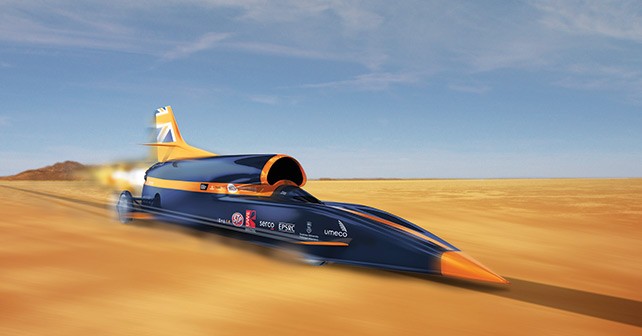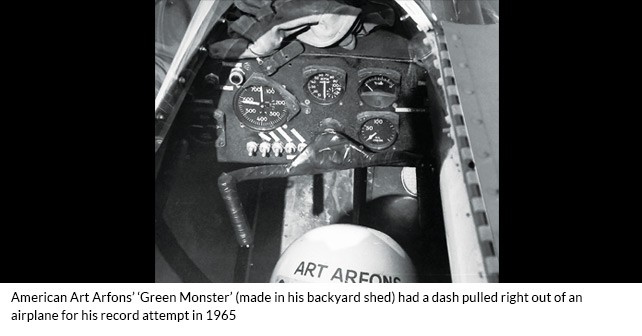How do you top going faster than the speed of sound? By sticking a few rockets and a jet engine on a car and attempting to go even faster, that’s how.
The end of 2014 was not the first time I got to meet Britain’s Royal Air Force pilot Andy Green, who since 1997 has been more commonly referred to as the ‘fastest man in the world’.
Green was a guest of the now defunct HRT Formula 1 team at the 2012 Indian Grand Prix where he was discussing the mind boggling way in which his team of land speed record chasers were intending to use a 750 bhp, V-8, Cosworth F1 engine, but more on that later.
EXTREME ENDEAVOUR
Exceeding the speed of sound on land ensured ever lasting fame for Green and the Thrust Super Sonic Car (SSC) that he piloted at Black Rock Desert, Nevada in 1997.
So one can’t help but wonder why Green, his boss and previous record holder Richard Noble feel the need to launch two assaults on the current mark of 1,227.986 kmph.
Yes, you read that right. Two more world record attempts in the all new Bloodhound SSC, which is expected to be assembled and ready for testing by this summer.
One to breach 1,287.2 kmph this September followed by an attempt to break the 1,609 kmph barrier in 2016. That’s 800 mph and 1,000 mph in Imperial Units, which rolls of the tongue a lot easier and is no doubt why the British-based Bloodhound SSC team uses it a lot more in the promotion of the attempt.
Of course the 1,000 mph run depends entirely on the team being successful at getting to 800 mph first in what is the car’s ‘test runs’ this year. Tests are being carried out, including on the car’s Rolls Royce EJ200 jet engine as well as a cluster of four or five Nammo hybrid rocket motors that will provide the requisite thrust to the car. In horsepower terms the total comes out to 135,000 bhp. Or in other words over eight times the total power of 22 Formula 1 cars.
THE BIGGER PICTURE
Not to be pedantic or anything but how exactly is performance like that, and a record for that matter, relevant to anyone except for bragging rights enjoyed by those who go for such an astronomical figure?
“We can’t afford to crash this,” Green tells autoX when we caught up with him in Delhi towards the end of last year. Well that’s obviously a no-brainer as Green explains some of the more minute details of the safety tests being conducted ahead of the run like how hydrogen peroxide – from the rocket motor - will react with various materials of the car as well as Green’s racing suit and boots.
“We’ll end up with a lot of hits on YouTube if we do (crash),” Green continues. “But we are not going to impress anyone with how good science and engineering is and so every single detail is being looked at.”
And that pretty much sums up the purpose of this extraordinary endeavour. Leeds, Cranfield, Swansea, Southampton, Leicster are some of the universities situated in the United Kingdom that Green rattles off while citing which aspect of the Bloodhound SSC they are involved in. Materials/hydrogen peroxide testing, aerodynamics, wheels, modelling on the shape of the steering wheel, respectively.
The list doesn’t end there, however. In fact Green doesn’t yet know how long the list really is as many of the sponsor companies of the Bloodhound SSC project are linked with other universities that the team members don’t know about as yet.
So the idea of students getting to put into action what they learn in books and lectures while working on such a high profile project is what Green feels justifies what many cynics could well see as a frivolous thrill-seeking expedition.
An example that Green gives is the fact that the Bloodhound SSC will have 192 aerodynamic pressure sensors fitted all over it in order to collect data during the record run.
Such a high number of sensors were put solely on the request of Swansea University who intend to use the car as a real world model to correlate their theoretical models that they have created in their labs.
PROCESSING INFORMATION
As an added bonus to any particulalry tech-savvy or curious people out there, such data will also be made available on the world wide web for anyone to download and see how the computer model matches with actual data from the world record attempts.
Other aspects of the car will also be similarly logged and the information shared with whoever wishes to learn about the project.
Of course, such enormous amounts of data – even if Green only needs a fraction of what is relevant to students and interested fans – will be a burden on the team and in particular the man in the cockpit if not properly processed.
“I’ve got a lot more data to go through in this run as compared to the Thrust SSC run in ’97,” said Green. “For this I have been working with a couple of universities on how to present the data and am using the same approach that jet fighters do.
“There’s a big display right in the centre that goes from zero to 1,000 mph, shows me the jet and rocket power output. So all I need to do is get the car up to a certain point and then slow it down based on specific cues that will tell me the right time – depending on how fast we are going - to deploy the air brakes, the parachutes and then the regular brakes.
“So there is a huge amount of information in just one instrument and it’s all about following the needle. So I have a lot more information I can use a lot simpler than any other driver before me.”
THE WOW FACTOR
Information and education are the two most common themes that Green kept revisiting throughout our interaction but it was hard to not ask about some of the more attention grabbing aspects of the attempt.
Like how a Cosworth F1 engine – mentioned at the start of this article - was intended to be used.
The 2.4 litre, 750 bhp, V-8 that revved at 18,000 rpm was supposed to be the pump for the rocket motor of the Bloodhound SSC due to the insanely high rate of combustion and the need for fuel to be pumped in during the run.
Cosworth pulled out of F1 at the end of 2013, however, as it has never really had much success with turbocharged engines that are being used in Grand Prix racing now, let alone those as advanced as the hybrid power units that power current F1 cars.
Cosworth’s departure meant sportscar manufacturer Jaguar coming on board and agreeing to supply the 5.0 litre, supercharged, V-8 from its flagship F-Type sportscar that produces 550 bhp for that purpose.
All very glamorous and heady stuff but as far as Green is concerned, its all about getting future generations excited about science and technology enough to get involved in helping the world reach the ‘technological future’ that is currently found in science fiction movies.
As for Green himself, world record attempts can also be left to future generations as at the age of 52, he does not intend to try for another record run after he is done with his two efforts this year and in 2016 to go faster than a speeding bullet.





























Write your Comment